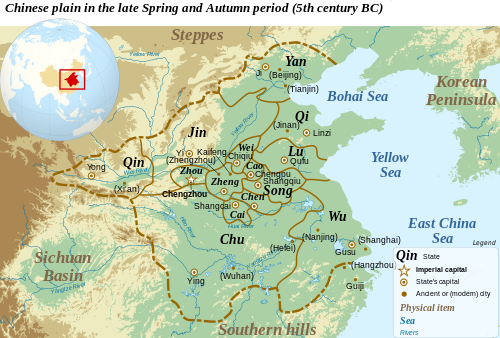
Back Tydperk van die Lente en die Herfs Afrikaans فترة الربيع والخريف Arabic শৰৎ আৰু বসন্তৰ যুগ Assamese Primaveres y serondes AST Yaz-Payız dövrü Azerbaijani Яҙҙар Һәм Көҙҙәр дәүере Bashkir Период „Пролети и есени“ Bulgarian শরৎ বসন্ত কাল Bengali/Bangla Marevezh an Nevezamzerioù ha Diskar-amzerioù Breton Primaveres i Tardors Catalan

| Spring and Autumn period | |||||||||||||||||||||||||||||||||||||
|---|---|---|---|---|---|---|---|---|---|---|---|---|---|---|---|---|---|---|---|---|---|---|---|---|---|---|---|---|---|---|---|---|---|---|---|---|---|
| Traditional Chinese | 春秋時代 | ||||||||||||||||||||||||||||||||||||
| Simplified Chinese | 春秋时代 | ||||||||||||||||||||||||||||||||||||
| Hanyu Pinyin | Chūnqiū shídài | ||||||||||||||||||||||||||||||||||||
| |||||||||||||||||||||||||||||||||||||
| Part of a series on the |
| History of China |
|---|
The Spring and Autumn period in Chinese history lasted approximately from 770 to 481 BCE[1][a] which corresponds roughly to the first half of the Eastern Zhou period. The period's name[b] derives from the Spring and Autumn Annals, a chronicle of the state of Lu between 722 and 481 BCE, which tradition associates with Confucius (551–479 BCE).
During this period, royal control over the various local polities eroded as regional lords increasingly exercised political autonomy, negotiating their own alliances, waging wars amongst themselves, up to defying the king's court in Luoyi. The gradual Partition of Jin, one of the most powerful states, is generally considered to mark the end of the Spring and Autumn period and the beginning of the Warring States period. This periodization dates back to late Western Han, c. 48 BCE – c. 9 CE.[9]
- ^ Hsu 1999, p. 547.
- ^ Lewis 1999, p. 598.
- ^ a b c Falkenhausen 1999, p. 450.
- ^ General Office of the State Council 2021.
- ^ Pines 2002.
- ^ Cook 1995, p. 148.
- ^ Kiser & Cai 2003, p. 512.
- ^ Zhao (2004).
- ^ Wong (2024), pp. 564–566.
Cite error: There are <ref group=lower-alpha> tags or {{efn}} templates on this page, but the references will not show without a {{reflist|group=lower-alpha}} template or {{notelist}} template (see the help page).
© MMXXIII Rich X Search. We shall prevail. All rights reserved. Rich X Search